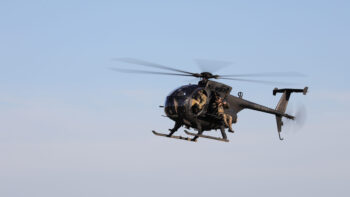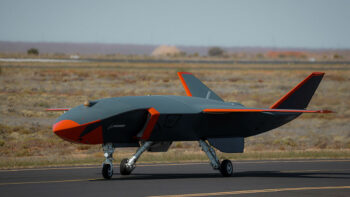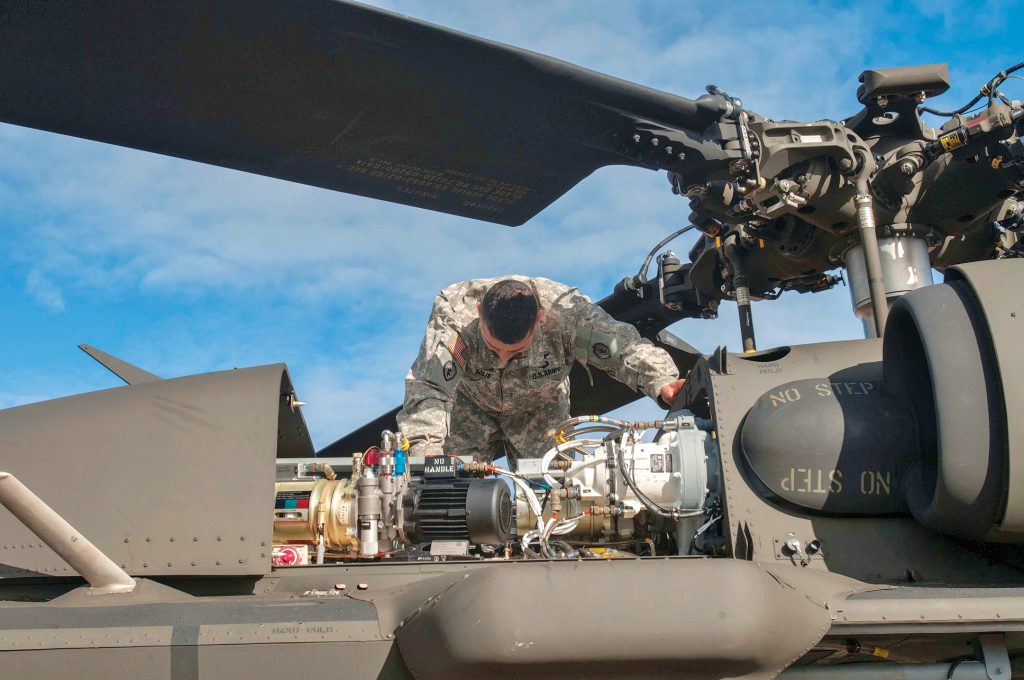
An Army maintenance test pilot checks out the engine on a Black Hawk helicopter.
UPDATED with GE’s response WASHINGTON: ATEC, the losing bidder on the Army’s Improved Turbine Engine Program, is asking Congress to reopen and extend the competition. The congressional Government Accountability Office rejected ATEC’s protest against General Electric’s successful bid late yesterday. UPDATE ATEC argues the Army made the award based the rival designs without testing full-up prototypes, but GE counters that years of earlier technology demonstration and maturation programs provided plenty of data.

A UH-60 Black Hawk takes off after unloading soldiers during an air assault exercise in Germany.
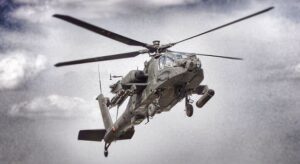
AH-64E Apache
“The GAO findings notwithstanding, a procurement this crucial should never be made based on paper proposals,” ATEC president Craig Madden said in a statement released late Thursday. (It’s worth noting ATEC didn’t object to this process until it lost). “Testing provides clear, unequivocal evidence of engine capabilities that cannot be obtained through a proposal. Therefore, we have recommended that Congress provide the funding to allow the Army to take both engines further into the Engineering and Manufacturing Development phase of the procurement before making a final selection.”
UPDATED Wait a minute, both GE and an independent expert said after seeing the original version of this article: There’s been years of testing, just not of the companies’ final, refined designs.
UPDATE CONTINUES “We scratch our heads a bit when someone calls these ‘paper engines,'” GE spokesman David Wilson told me. “People may not quite understand that both ATEC and GE have run two full engine prototype tests through the Advanced Affordable Turbine Engine (AATE) program and the Technology Maturation & Risk Reduction (TMRR) contracts over the past 12 years.”
UPDATE CONTINUES 12 years is actually an understatement, said an engineer familiar with the program’s long and often painful history. “The plans and studies went back to the late ’90s,” with what was then called the Common Engine Program. “It’s a little misleading to say it’s a paper competition because they’ve spent 20 years developing it.” UPDATE ENDS
Given the history, the additional cost, legislators’ longstanding reluctance to overrule awards already upheld by GAO, and recent signs of strong support for other parts of the Army’s ambitious modernization plans, the odds for ATEC look long. But it’s not impossible, as shown by the history of the biggest Pentagon program ever, the F-35.
ITEP is an Army effort to re-engine thousands of aging Apache and Black Hawk helicopters and, potentially, power some of its new Future Vertical Lift aircraft as well. It’s become routine for the losing bidder on such big programs to appeal to the Government Accountability Office, as the Advanced Turbine Engine Company — a joint venture between Honeywell and Pratt & Whitney — did in February after GE won. It’s become equally routine for GAO to deny those protests, as the agency did yesterday. What’s not routine is what ATEC did next: appeal to Congress to overrule both GAO and the Army.
ATEC’s argument? The Army awarded the ITEP contract to rival GE after evaluating only the two firms’ proposed designs, without building and testing actual engines, which would have cost more but also would have provided better data. So ATEC is asking Congress to fund both firms, not just GE, to build working prototypes and compel the Army to make its final decision based on physical tests.
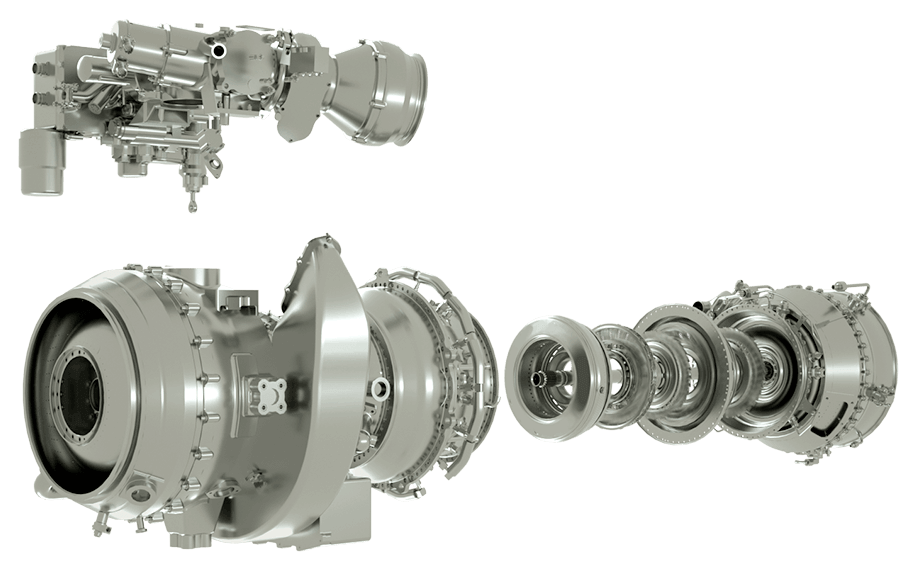
Views of the General Electric T901 Improved Turbine Engine for Army helicopters
Testing, Testing

GE’s F135 Alternate Engine for the F-35 Joint Strike Fighter
Experts generally agree that physical testing is a better way to choose between competitors than just judging designs. “Yes, it will cost more for EMD, but the overall cost to the taxpayer once in production will be much less,” one retired Army aviator told me. “Building a turbine engine from an engineering plan and putting it on a test stand is hard work, full of unexpected outcomes — and once you have the engine working on the test stand, there is another big leap to full scale production. [Without testing both alternatives], I believe we are on a path that will ultimately deliver an engine of limited value that will cost more than expected and arrive later than planned.”
Now, legislators have forced the military to fund a backup engine before, on the infamous F-35 Joint Strike Fighter (and the F-16). Ironically, the beneficiary in the F-35 program was GE, which doesn’t want its work on Alternate Engine Program for F-35 to become a precedent for ATEC getting to build an alternative engine for Army helicopters. GE can make a reasonable argument that the two cases are not comparable. Congress insisted on a backup plan for the F-35 because the primary engine maker for the jet, Pratt & Whitney (which today owns half of ATEC), had suffered a series of high-profile problems with its earlier engines for the F-15 and F-16 fighters. By contrast, GE offered the lower-risk option for ITEP, a traditional single-spool turbine (designated T901) as opposed to ATEC’s more ambitious and advanced dual-spool design (T900).
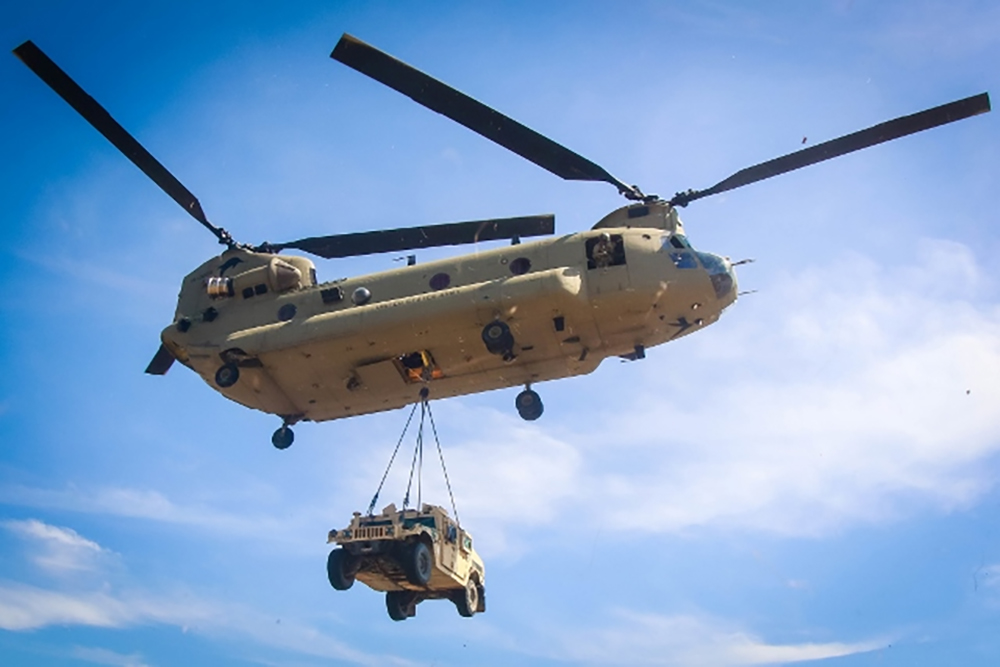
A CH-47 lifts a Humvee
Big Picture
In other areas besides helicopter engines, however, the Army’s been more willing to take risk. It’s exploring breakthrough technologies for all of its Big Six modernization initiatives — including aviation: Priority No. 3 is a new fleet of high-tech, high-speed Future Vertical Lift aircraft. One of the two leading FVL competitors, Bell, has publicly declared that it makes no sense to spend billions re-engining old helicopters with ITEP instead of investing in the next generation. The Army argues it’ll take decades to replace all its current aircraft with FVL on any reasonable budget. The service has also said the scout variant of FVL, the Future Attack Reconnaissance Aircraft, should use ITEP engines — if possible.
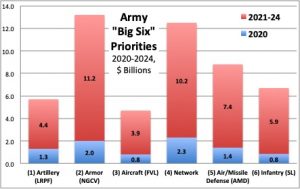
LRPF: Long-Range Precision Fires. NGCV: Next-Generation Combat Vehicle. FVL: Future Vertical Lift. AMD: Air & Missile Defense. SL: Soldier Lethality. SOURCE: US Army. (Click to expand)
To fund these innovations, the Army has made painful cuts elsewhere, truncating or cancelling 186 programs. Most prominent is yet another aviation program, the Block II upgrade for the CH-47F Chinook heavy lift helicopter. Yet despite dismay in Pennsylvania, where the Chinook is built, and appeals by the manufacturer, aerospace giant Boeing, Congress has only questioned the Army’s decision, not overridden it.
That said, the legislative process is hardly over, with big battles looming over total federal spending and budget caps. But two key committees, the House appropriators and Senate authorizers, have already passed their draft bills. The other two, the Senate appropriators and House authorizers, are well along, with House Armed Services beginning formal mark-up of its bill next week. That leaves little time for Congress to advance amendments overruling the Army on either CH-47 or ITEP — even if it wants to, of which it’s shown little sign.
Eight ‘capability coalitions’ are rushing arms to Ukraine. Here’s who will donate what. (EXPLAINER)
NATO has established eight different capability coalitions designed to get critical systems or ammo into Ukrainian hands quickly. Here’s a deep dive into how they’re all faring.






















